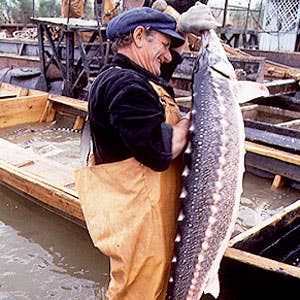
In Russia's Caspian region, sturgeon are netted from roughly April through July and September through December. Mature female sturgeon are identified by their bloated bellies—roe accounts for up to 10 percent of a sturgeon's weight. (Fishermen are supposed to release the males and immature females.) Because roe must be extracted from living fish, the mature females are anesthetized or stunned, usually by a blow to the head, and delivered live to the fishery. There, a caviar master removes the sack of roe and rubs it over a fine screen to remove the membrane and any blood. (The sturgeon themselves are processed as food.) The roe is worked through a finer screen, rinsed, then salted. The master determines how much salt—3 to 5 percent of volume—to add to each batch. (Some processors use borax, but borax-treated caviar is prohibited in the U.S.) In general, the freshest roe requires the least salt. Look for the words molossol or malossol (meaning ''little salt'') on the label. Caviar is packed into four-pound tins for export and repacked into smaller containers by importers.
Keep Reading
Continue to Next Story










